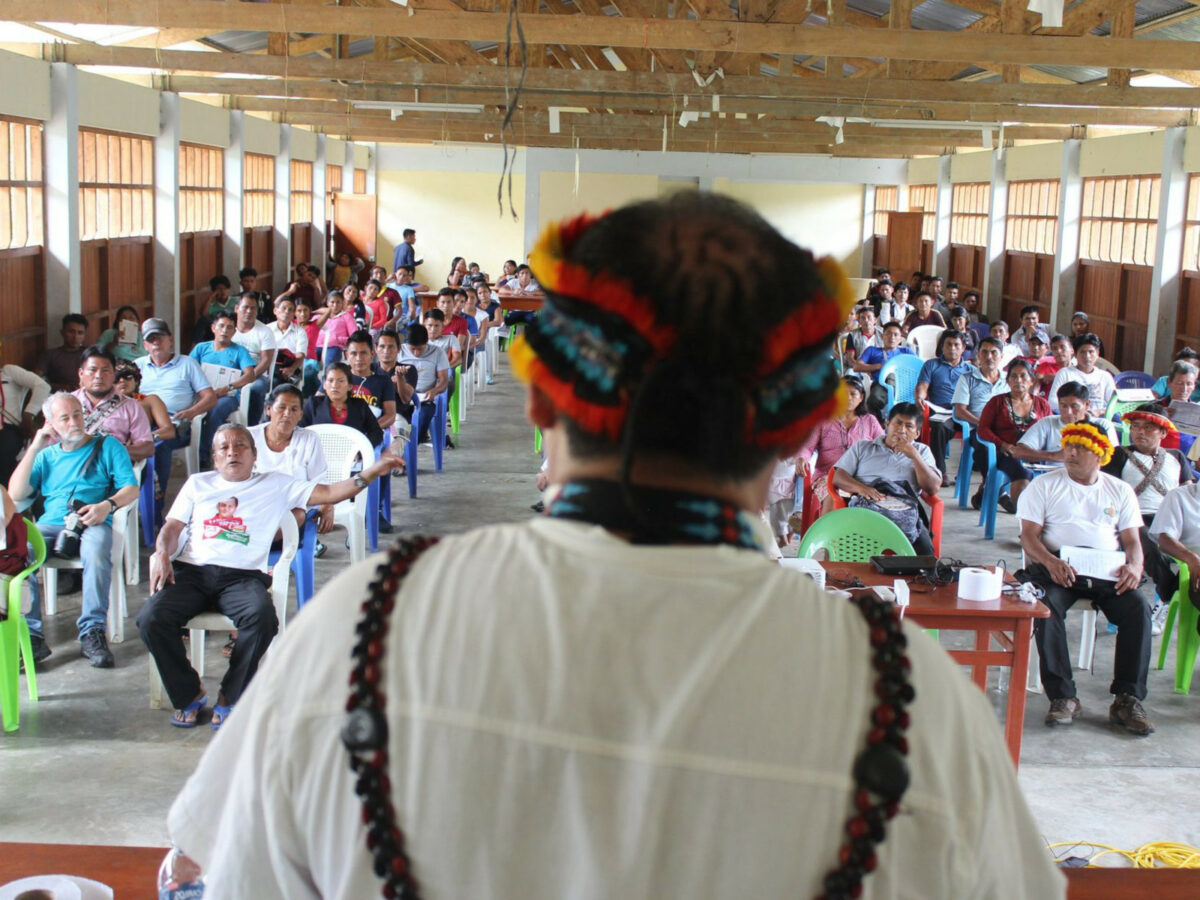The Permanent Forum on Indigenous Rights this year casts a spotlight on the self-determination of Indigenous peoples, a fundamental pillar for the preservation of the Amazon and its custodians. In the heart of Peru, a revolutionary movement unfolds as Amazonian communities pioneer the creation of Autonomous Territorial Governments (ATGs), a beacon of hope and autonomy.
With unwavering support from Amazon Watch, particularly aiding the Wampis and Achuar peoples, these communities are forging a path towards self-governance, embodying the resilience and unity necessary to combat the encroaching threats on their sacred lands. This movement isn’t just about reclaiming territory; it’s a profound statement of identity, culture, and the inextricable link between Indigenous rights and the health of our planet.
So what exactly are these autonomous Indigenous governments, how do they work, and why are they so important for the fight against the threats to the Amazon?
Faced with the ongoing invasion of the Amazon and the advance of extractive activities, the Peruvian Indigenous movement, led by AIDESEP and with the support of international allies, has worked for decades to gain official recognition of land titles for as many communities as possible to safeguard the forest and guarantee the lives of Indigenous peoples. Additionally, the government created reserves for isolated peoples and established communal reserves. These are two mechanisms frequently used to protect the territory.
Peruvian law establishes “native communities” as the only legal owners of their territories. However, obtaining legal recognition and titling for these communities involves a cumbersome, complicated, and expensive administrative process. This process often takes many years and receives little to no government support. Additionally, the land between these territories may be controlled by the government, forest concessions, or private landowners. Consequently, the 51 Indigenous groups residing in the Peruvian Amazon possess only portions of their ancestral lands, resulting in a fragmented ownership pattern.
While the struggle for land rights has been invaluable, it is widely recognized that territorial defense must extend beyond communal land titling. Indigenous Peoples consist of multiple communities with shared histories, cultures, and languages, yet their territories have never been fully acknowledged by the government and other entities. When territorial decisions are fragmented across individual communities, governments, companies, illegal economic actors, and land settlers can exert pressure on small family groups rather than facing the collective community.
This fragmentation has caused numerous issues for Indigenous peoples. In response, they have wisely chosen to establish broader governments that represent entire peoples. This approach aims to reclaim ancestral lands and regain control over their full historical and cultural domains, aligning with international law requirements. These broader governments do not replace existing communities; instead, they unify them to make collective decisions and represent the united will of the people. Consequently, in Peru, Amazonian communities are actively creating Autonomous Territorial Governments to achieve these goals.
What are ATGs?
Autonomous Territorial Governments (ATGs) are established by Indigenous peoples to reclaim their rightful territories and manage them in ways that ensure forest protection and cultural continuity. Elected authorities represent the community, executing a “life plan” that directs their collective future. Each Amazonian group creates its own governance model, striving for agreements with the Peruvian government to secure rights to education, health, and economic activities. ATGs also aim to resolve internal community conflicts.
ATGs function as the governing bodies for their peoples, managing education, health, and other services while setting development priorities aligned with their cultural perspectives. This arrangement does not isolate them from the Peruvian government; rather, it allows for integration into the national political framework. Building ATGs empowers Amazonian communities to protect their lands from external threats, such as oil companies or settlers, and facilitates collective negotiations with the Peruvian government to safeguard their rights and access public services.
ATGs are under threat
The ATGs symbolize the Indigenous peoples’ ability to shape their own collective futures and build collective power, yet they encounter numerous threats. Oil companies, for example, often try to undermine their decision-making rights regarding their territories. These companies intentionally conduct negotiations with only a few communities and tend to keep these discussions private. Similarly, mining operations in the Awajun and Wampis regions resist the ATGs because these governance structures limit extractive activities to protect the forest. Furthermore, the Peruvian government frequently denies the legitimacy of Indigenous self-governance.
Despite these challenges, ATGs continue to operate based on the Indigenous peoples’ initiative, employing various methods to gain legal recognition from the Peruvian government. These methods include legal actions, legislative reforms, and administrative processes, all underpinned by international law. Notably, the ILO 169 Convention on Indigenous Rights, which Peru has ratified, explicitly supports the collective land ownership rights of Indigenous peoples.
How Amazon Watch supports these efforts
For over two decades, Amazon Watch has collaborated with the Achuar people of Pastaza to advocate for their opposition to oil activities and uphold their territorial rights. This advocacy has recently extended to include the Wampis, Awajun, and Chapra peoples, aiding in the defense of their ancestral lands. Our support enhances their self-organization through the Amazon Defenders Fund, field advice, and global dissemination of their decisions.
We also back AIDESEP, the national representative of Amazonian peoples in Peru. In October 2023, AIDESEP hosted a significant gathering of all existing ATGs in the Peruvian Amazon, resolving to facilitate the formation of ATGs for all Amazonian communities. Additionally, we are working to increase international recognition and support for ATGs, highlighted by our participation in the United Nations’ Permanent Forum on Indigenous Rights in April, alongside AIDESEP and representatives from the Chapra, Wampis, and Achuar peoples.
Our commitment remains firm in supporting the establishment of Indigenous self-governance structures. Recognizing this as their inherent right, we aspire for it to gain universal recognition.














